Old Russian architecture is invariably associated with carved platbands on the windows. This form of design of houses is distinguished by species diversity. A few decades ago, craftsmen with their own style of creating decorative elements lived in each region. Today's return to the roots is accompanied by a revival of interest in window decoration using carved platbands.
Framing purpose
The very word "platband" speaks of its location - "on the face", that is, one of its functions is to decorate the facade of the building. Therefore, people tried to express their individuality through it and decorate the windows with carved frames. In addition to the decorative role, window trims primarily perform a constructive function, closing the gap between the frame and the opening. This prevents dust from entering the house, protects against precipitation, drafts and extraneous sounds.
In the old days, carved platbands were also attributed magical properties. It was believed that framing a window with a certain shape of a bar protects from the evil eye and serves as a kind of amulet. Therefore, various figures and plants bearing a specific semantic load were seen in bizarre patterns.
In modern architecture, the functional purpose of platbands for windows is as follows:
- A well-chosen carved design allows you to visually stretch a low building or expand a narrow wall.
- The opportunity to show individuality and decorate the building in accordance with the trend of a particular era.
- Allows you to achieve a single architectural ensemble between all the buildings on the site.
- Protection of cracks from the penetration of external negative factors (precipitation, noise, dust).
- It is one of the elements of thermal protection of the house.
Remark ! Sometimes platbands are the only option for framing a window. This mainly concerns wooden log cabins, when the use of other materials is unacceptable due to the loss of a harmonious appearance.
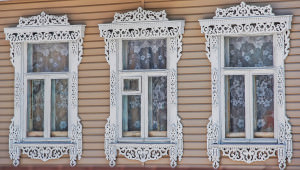
Carved finishes, especially those made of wood, have a number of features that should be taken into account during the period of operation:
- Dependence on the influence of atmospheric factors. Moisture and temperature changes invariably damage the decorative design.
- When choosing a frame, you should take into account the properties of the rock from which the platbands are made, and take care of high-quality processing. Timely preventive measures extend the life of the product for the window.
- Difficulties often arise when combining wooden carved elements with modern plastic frames. With this combination, it is preferable to install windows that imitate a wooden texture.
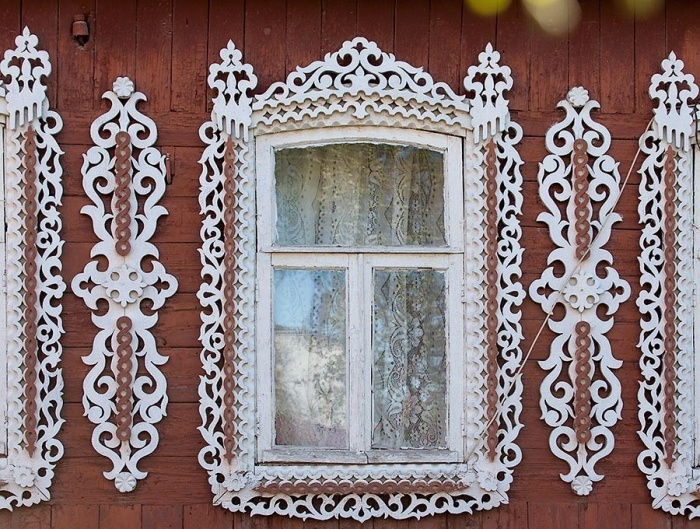
The value of carved elements
The desire to comply with ancient traditions requires knowledge of the meaning of various elements of carved architraves:
- The sun, as a rule, is placed on the kokoshnik. It symbolizes life and energy.
- The personification of wisdom and fertility lies in the image of a snake.
- The symbol of harmony between spiritual and material aspirations is a cross in a carved platband.
- The feeling of unity with nature is emphasized through vegetation.
- Earrings testify to the hospitality of the owners of the house.
- The connecting element of all times is the silhouette of a bird on the window.


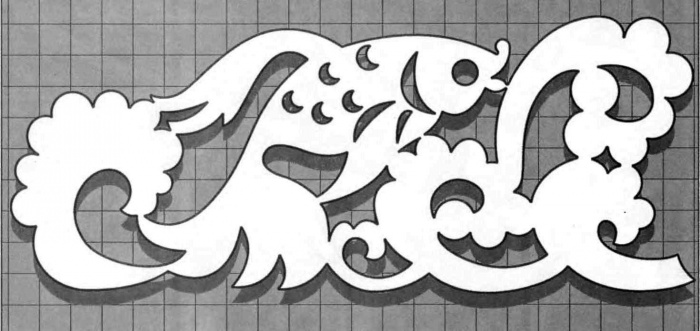
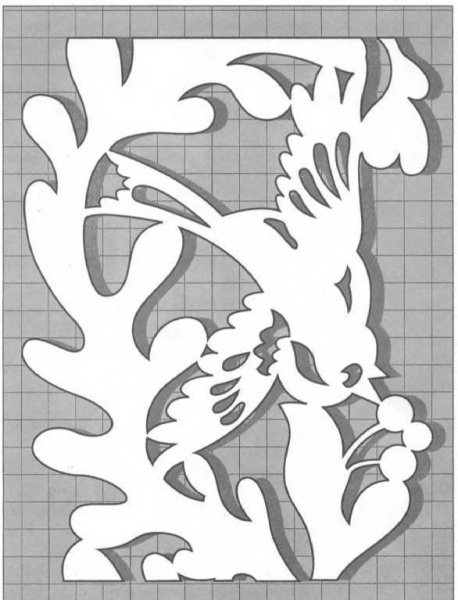
Characteristics of materials and forms
For the production of platbands on windows, natural and artificial materials. Traditionally carved elements were made of weather-resistant wood. Characteristics of the properties of individual breeds will help determine the most suitable type:
- Larch is minimally susceptible to decay processes, but is not suitable for the production of carved frames due to its fragility.
- Aspen, alder and linden are the most convenient species for creating openwork decor on windows. However, the malleable and soft wood of carved architraves needs special treatment due to its ability to absorb moisture well.
- Oak, ash or beech window trims are resistant to negative weather conditions, but the processing of carved elements is burdened with difficulties, overcoming which you will get a durable decor.
- A good choice would be birch or pine wood, which allows you to perform a neat carved decor. At the same time, the platbands have sufficient strength for external use.
- Small carved window decorations, which are fixed on the main elements, can be made from cherry or apple.
Advice ! Regular coverage updates wooden architraves waterproof paint or varnish will provide them with a long service life.
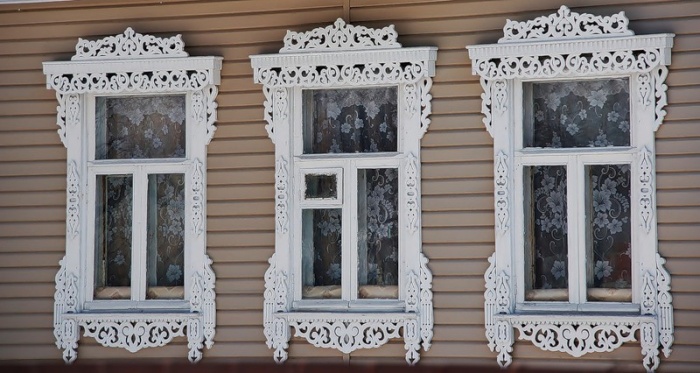
What other materials are used in the production of linings for windows and what are their features, we will consider below:
- Laminated MDF allows you to accurately simulate the color of any type of wood, but is intended exclusively for indoor use.
- Plastic windows are harmoniously combined with platbands made of similar material (PVC), which is not subject to decay, has a wide color palette, resistant to solar radiation. The color of the platbands is selected taking into account the finishing of the house to match or contrast with the facade.
- For round windows, polyurethane products are ideal, characterized by lightness and unpretentious care.
- Metal strips are fixed in order to protect the mounting seam, connecting them into a single whole with a profile box.
There are two main ways to install platbands:
- Invoice - the most common method in the design of windows. For fixing, special glue or nails are used.
- The telescopic method involves the L-shaped form of manufacturing the casing, which allows you to fix the product by entering the grooves of the box. It is most often used for finishing doorways. Its characteristic difference is the absence of traces of fasteners.
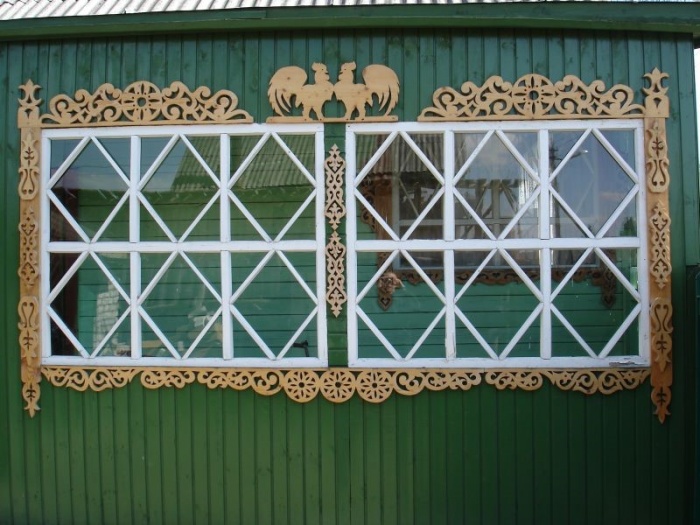
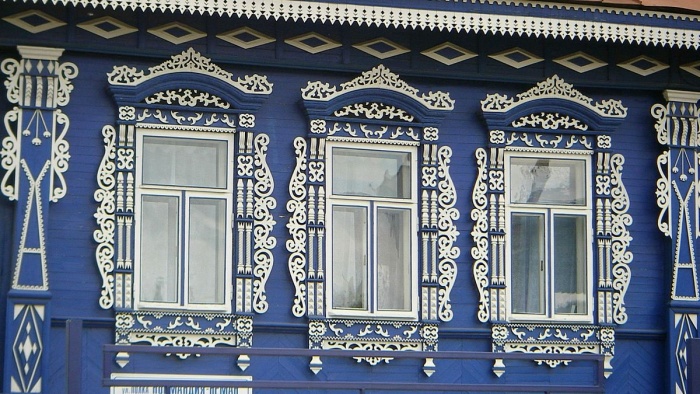
Patterns and types of thread
The carved forms of the architraves give the window individuality, but in order to make them, you will definitely need templates. The presence of woodcarving skills allows you to choose a complex ornament. If the ability to work with wood is not enough, it is better to find a light pattern for window trim. We suggest exploring:
- variants of templates of single elements and their general appearance;
- top, bottom and side decoration details.
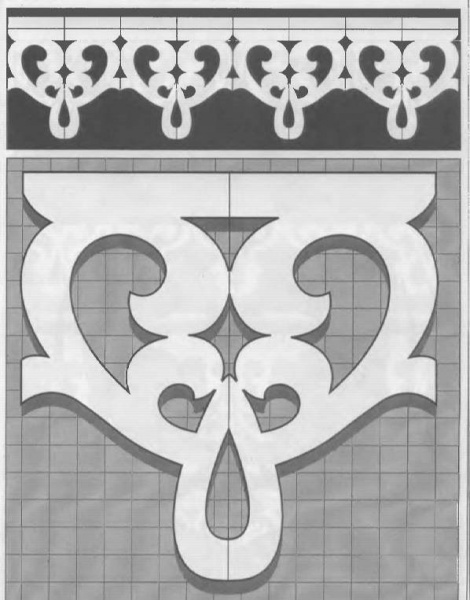
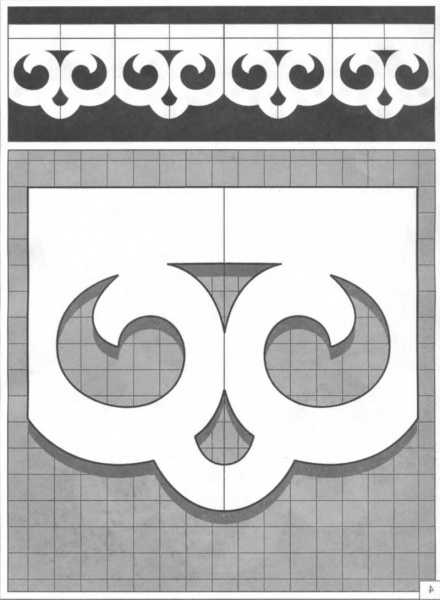
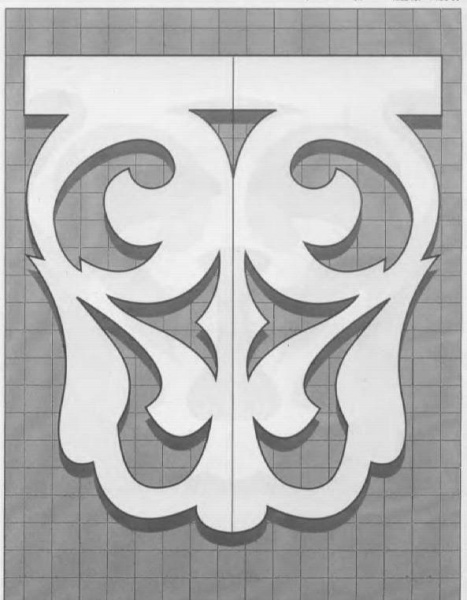
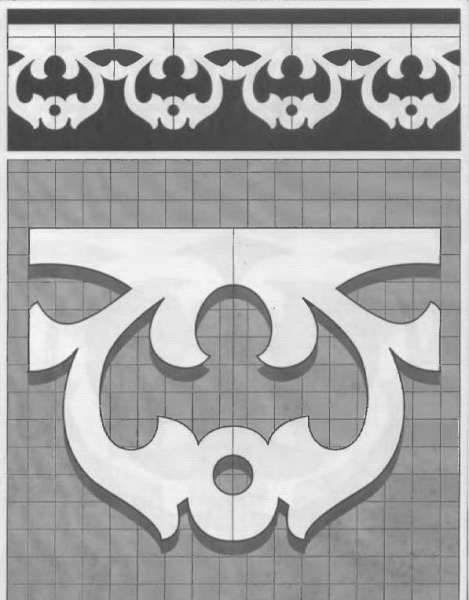
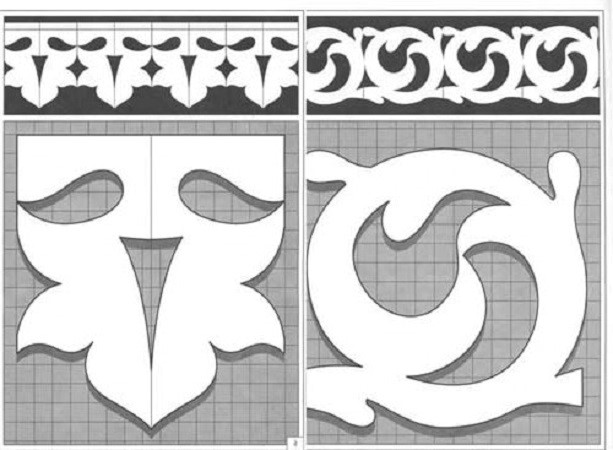
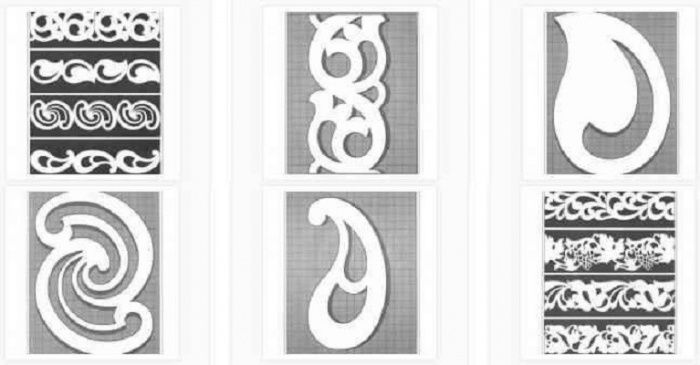
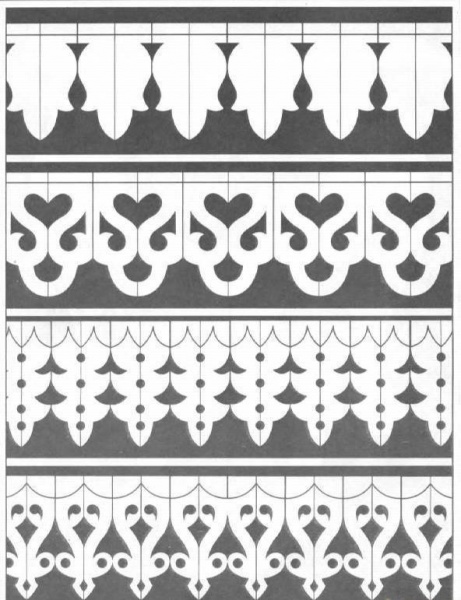
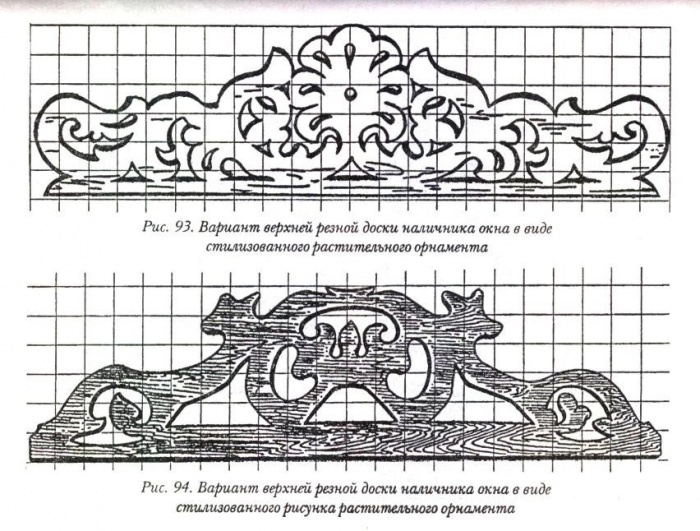
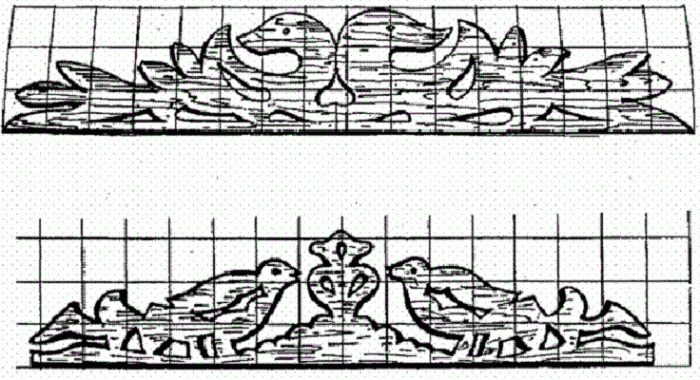
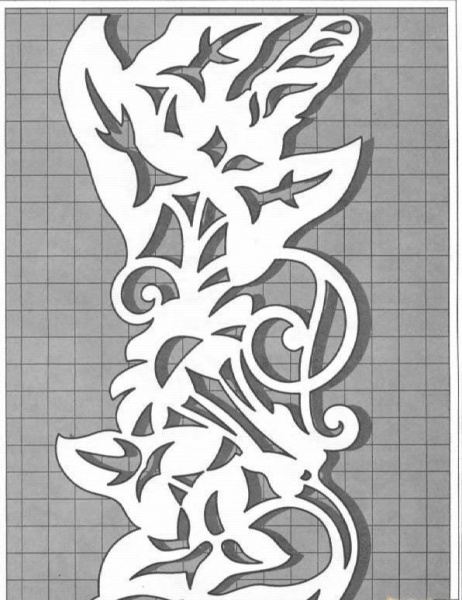
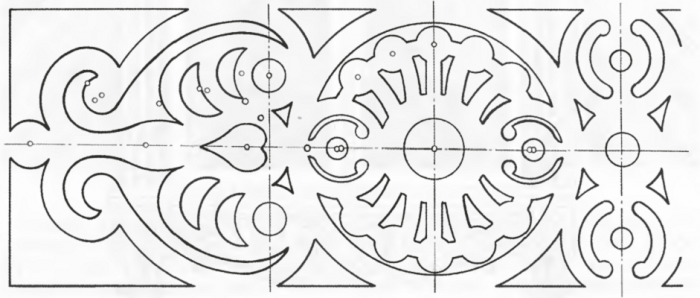
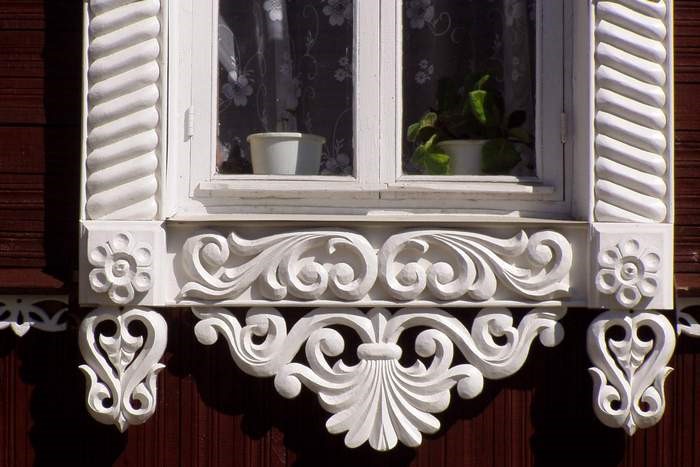
You can copy them completely or add your own details to the pattern. The picture of the carved platband you like or its fragment must be scaled up taking into account the size of your window. For the manufacture of carved templates, fiberboard, thick cardboard or paper is used. It is desirable to decorate windows with platbands with the same thread. Please note that it is much more difficult to make small carved elements, and they become unusable faster than others. In this case, a partial replacement of the frame will be required.
Warning ! Be sure to take into account the slope at the top of the carved casing. This will prevent the accumulation of snow and ensure timely drainage of water.
The upper part of the window casing is called a kokoshnik, the lower part is called a towel. The contours of plants, images of animals and geometric figures were most widely used in the ornamentation of carved architraves.
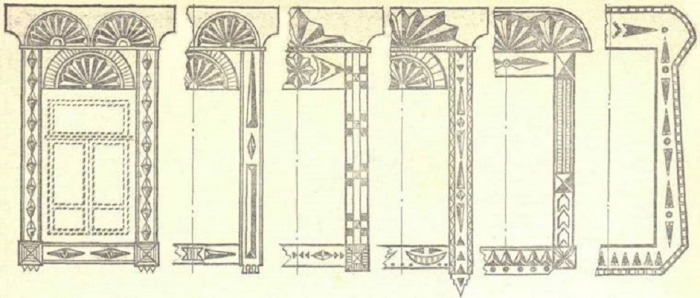
The key details of the drawing for any window trim are:
- lower bar or window sill;
- vertical rail;
- top bar.
The scheme can also contain all kinds of hangers, flowerpots or a diadem. Detailed description the names of carved decor elements are shown in the diagram below:
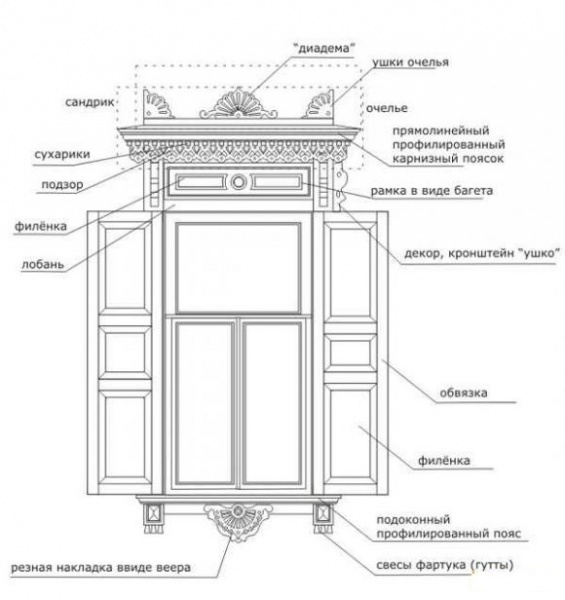
If your windows are of different sizes, experts advise making a drawing with an intermediate repeat repeating required amount once. For rapport, you can choose one or two elements that repeat alternately. An example of such a scheme is shown in the photo below:
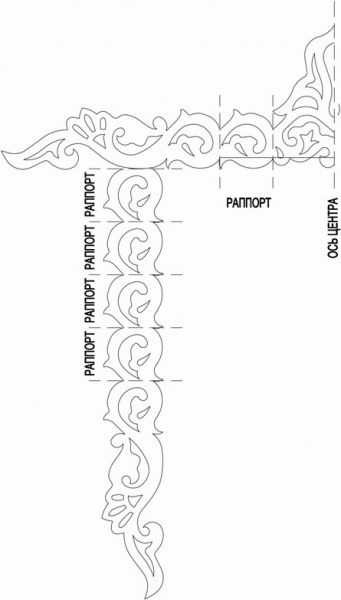
There are several ways to make a wooden carved frame on the windows:
- The greatest decorativeness and delicacy are characterized by slotted platbands. The product is made of light-colored wood or is subsequently coated with white paint. This window design on a darker wall looks sophisticated and elegant, vaguely reminiscent of Vologda lace.
- With overhead threading, separately cut parts are fixed to a solid board by gluing or nailing. This technique allows you to arrange a window with a simple casing. Protruding elements are often covered with contrasting paint.
Sometimes both types of thread are combined.
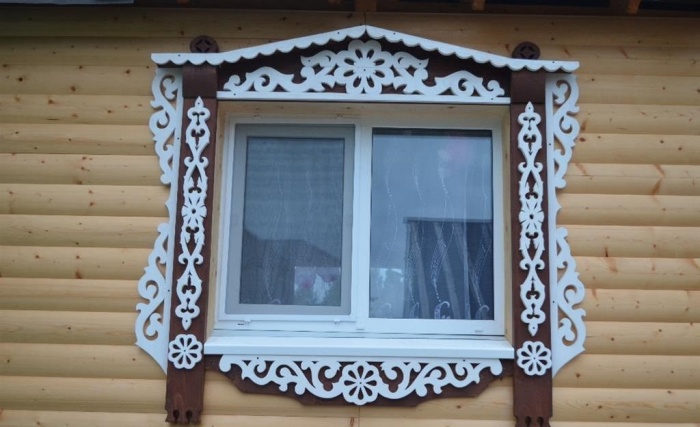
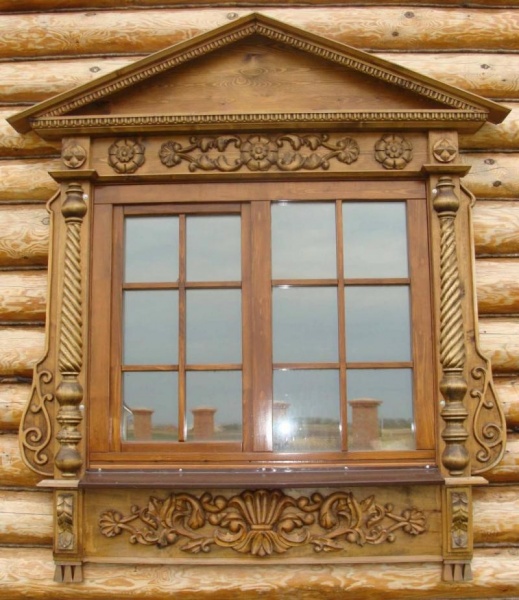
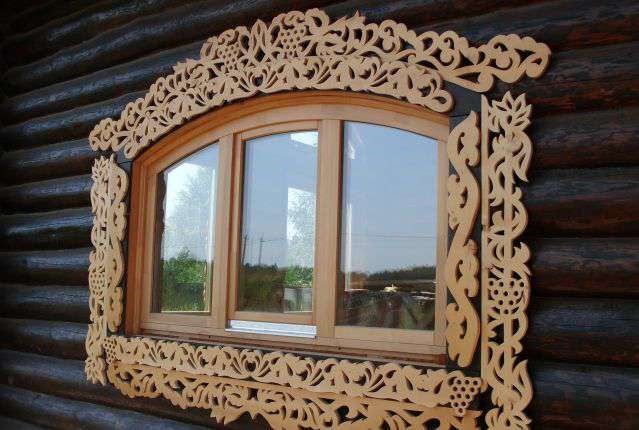
Manufacturing process
Having decided on the pattern, material, type of thread and method of fastening the platbands, you can directly proceed to the manufacture of carved framing for windows.
Important ! Drawing on the workpiece needs correct placement. To prevent cracking of the thread will allow the location of the elements along the fibers of wooden blanks.
Places of the pattern where it is necessary to make cuts, it is better to mark with color. The work on the manufacture of platbands consists of the following stages:
- Taking measurements from the window.
- For slotted thread boards are selected minimum thickness 30 mm, the overhead method allows the use of wood with a thickness of 10 mm. All work is done with dry lumber.
- Blanks are cut out.
- For a snug fit of the carved casing from the inside, the wood is selected to an insignificant depth (1-2 mm).
- The pattern applied using the template is cut out. To form holes, drills of various diameters are used, a jigsaw is needed to make cuts. To make a beautiful cut, the entry point of the jigsaw is marked with a drilled hole.
- All carved elements of the platband for the window are cleaned with sanding paper. From not through holes wood dust is removed with a vacuum cleaner.
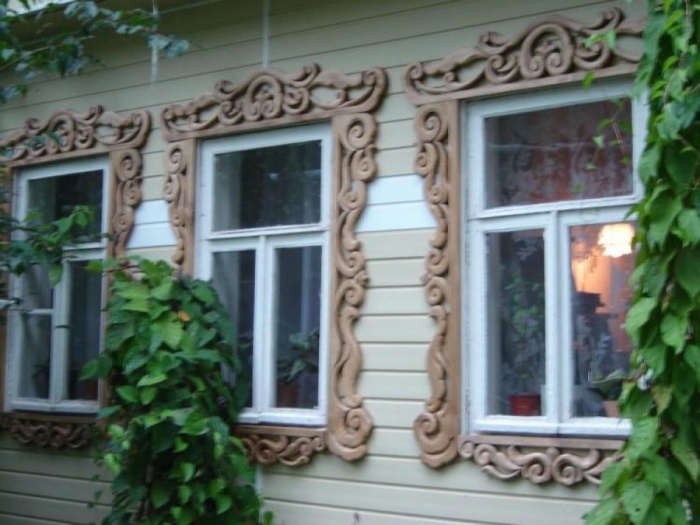
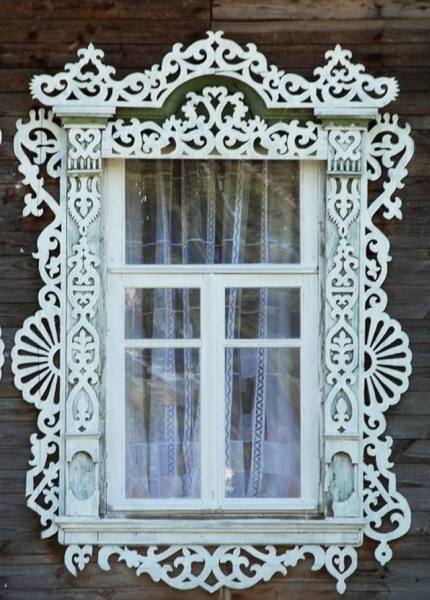
Laid on thread provides for fastening finished elements to a wide casing on nails with removed caps. Strengthen the strength of the connection will allow glue applied from the wrong side of the casing. The use of self-tapping screws is not recommended due to the risk of damage to the carved section of the connection.
Carved platbands are installed on wooden windows using deaf or through spikes. The first option is distinguished by a reliable connection and a complex installation process. The second method is simpler, but less reliable. Installation of carved elements on plastic window carried out using liquid nails.
Preliminary protective treatment of carved architraves and regular preventive care will ensure long-term preservation of the attractive appearance of the window.
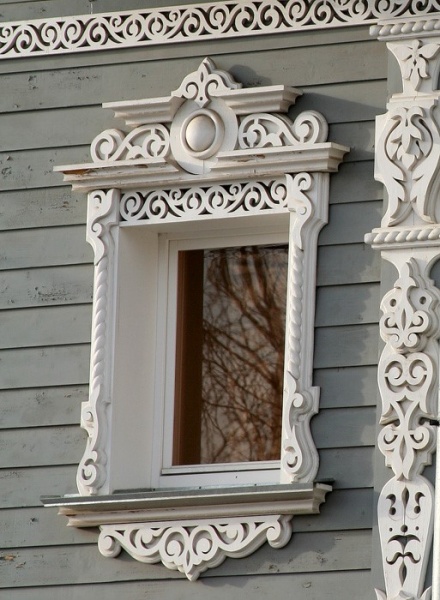
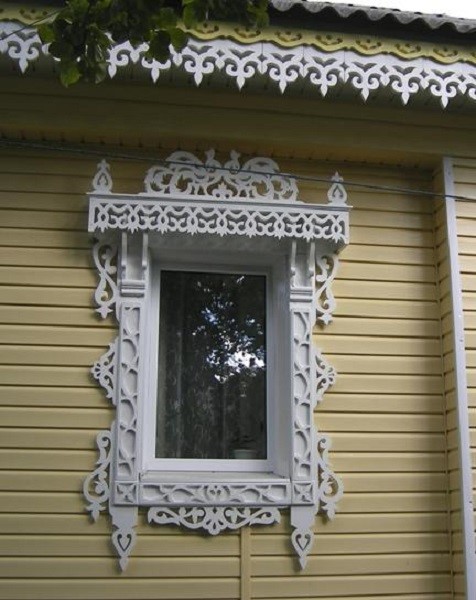
Beautiful things are the weakness of every person, and if they are made with their own hands, pride in oneself overwhelms the senses. It is to such creativity that woodcarving can be attributed. How original and unique your house looks with carved architraves, where the owner put a particle of his soul into the work.
What is a cashier? It looks like a decorative overlay and is mounted with outside windows and is an ornament where a decorative technique is used.
It can be:
- Plants showing unity with nature.
- The sun, located on the kokoshnik, personifies energy and life.
- Earrings indicating the hospitality of the owner of the house.
- The cross, symbolizing the harmony between the spiritual and material world.
- A bird that speaks of the unification of all time.
- A snake representing fertility and wisdom.
- Wings, confirming strength and power.
Platbands are different in style, material, shape. They are the completion of construction, which emphasizes the individuality and style of the home. And at the same time, they perfectly mask all the flaws of the opening (slit).
Application area
 Widespread use of framing around various openings has found itself in doors and windows. The location of the slats can be both on the outside of the street and indoors.
Widespread use of framing around various openings has found itself in doors and windows. The location of the slats can be both on the outside of the street and indoors.
Basically, platbands of the same type are installed, but the thread may differ. And at the same time, a common theme is preserved. For example, in a children's room, the plank will be with a bunny. Flowers are carved around it. Then in the kitchen a bear cub should also be framed with the same flowers.
Now considered a brand plastic double-glazed windows. Some people manage to put a wooden plank on them. In this case, you need to paint it in White color Or choose a double-glazed window made of wood.
The slats around the window opening perform some functions:
- Combine all the buildings in the yard into a single style.
- Reduce heat loss.
- Protect from dust and litter, moisture, draft.
- Increase sound insulation.
- I emphasize the uniqueness of the residential building.
- An opportunity to express the traditions of the region, family, country.
- The ability to visually stretch and expand the house.
- They complete the building.
- Close the mounting seams.
In the time of our ancestors, the owners of houses firmly believed that the slats on the windows had not only a beautiful and original look, but also were protection from the evil eye and evil spirits. Therefore, they paid close attention to their manufacture, and tried to perform only in a unique form.
Kinds
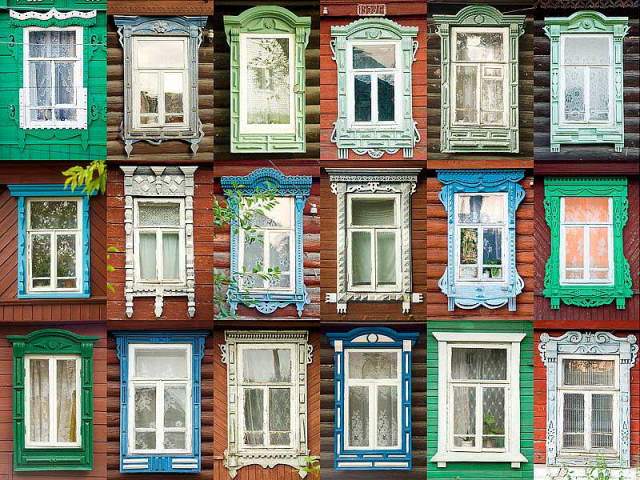
The product can be a colorful luxurious carving or have a modest shape. The lower part of it is called a “towel”, the upper one is called a “kokoshnik”.
If we consider the platbands by material, they can be from:
- tree;
- metal;
- plastic;
- foam and polyurethane;
By form:
- drop-shaped;
- curly;
- semicircular;
- flat;
Before starting work, it is worth stocking up on templates or stencils of carved platbands, without their help it is impossible to achieve an excellent result. And to perform your work without them is available only to a master who has been working on wood carving for more than one year.
You can get stencils for today freely - these are in stores, magazines, and the Internet.
They can be applied to any pattern that the customer or the master wishes. Contours of plants, figurines of animals, ornaments of geometric lines and figures are very popular.
The style of the product can be different, and here the most unusual fantasies of the performer are realized.
How to do?
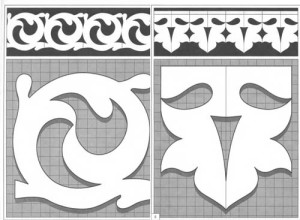
Photoshop stencils
Stencils are made in different ways:
- With the help of a graphic editor. The desired image is located and processed by Photoshop. Every computer has the Paint application, it is used for editing, coloring and drawing. By visiting this page, you can design personal images ranging from simple to complex projects. It is possible to add text and various elements to existing image files.
- Photocopies. A picture is selected that you really liked and when copied, it immediately increases to the desired size. The second option is to scan and print the sample on a printer.
- By hand. It uses the technology of scaling (copying) and by cells (linear scaling).
Thread making
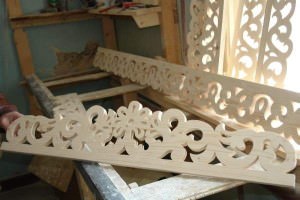
We make a template from cardboard, the size should be natural. A personal template is made for all elements of the picture.
Now, you need to lay it on the board and circle the outline with a pencil.
We outline the places for the holes. Let's say you need to cut a leaf. To begin with, a hole is drilled, then a leaf appears with a jigsaw. Following the holes, we make all the internal patterns, then move on to the external ornament.
There is a copying method for drawing a picture. Here we use carbon paper. We trace the drawing through it onto the board and get a pattern on the wood.
Required tools:
- sandpaper of various numbers;
- jigsaw;
- drill with a set of drills;
- a set of chisels;
Instruction:
- We make the pattern the same on all windows. To do this, use a stencil or sketch.
- We place the drawing on the workpiece correctly, where we place all the elements not across the fibers, but along. That will not allow the thread to crack.
- We paint over the slotted areas with a pencil.
Wood carving is done in two ways:
- Invoice. In this option, we use a thinner workpiece, then the work is simplified. Here we make separate elements, which we will then fold on a single board.
- slotted. In this case, we make a cut through, we get a kind of lace, which is exquisite and beautifully frames the window.
Platband installation
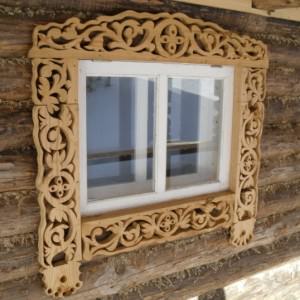
Creating a beautiful product is one thing. But properly fixing it to the window is another.
Aesthetic appearance, and long service life closely depends on the quality of installation of platbands.
There are two ways to mount on wooden windows:
- Through spike. The method is simple and not very reliable. Spikes should be installed in places where they will be invisible. This provides additional moisture protection.
- Silent spike. The spike goes into the casing. Whereas a hole is drilled in the frame for it. It is necessary to lubricate the spike with glue and bring it into the groove. Fastening is considered difficult, but it is more reliable than the first method.
Fastening to a plastic window is carried out with liquid nails, in order to avoid violating the integrity of the structure.
Walkthrough:
- We take measurements from the window.
- Choose a type of wood and dry it well. The choice of width and height does not play a big role for carved platbands, the main thing is that the thickness is 3 cm. This is if the thread will be slotted, for the invoice - 1 cm.
- We process the tree with sandpaper, starting with coarse-grained, and at the end with zero.
- Cut out stencils.
- We take a simple pencil and apply a drawing or pattern on the front side of a wooden surface. We paint through the cuts.
- Let's start cutting out the pattern. Let's start with the through holes. Where the jigsaw will enter, it is advisable to use a drill for a more accurate cut.
- The holes are carefully processed with sandpaper.
- To remove dust from blind holes, use a vacuum cleaner.
- When using overhead thread elements, we fasten them to nails without hats. And, for reliability, let's go through the glue on the back side.
- Now take a damp rag and wipe the pattern until the area is completely dedusted.
- The finishing operation will be considered a stain, with which we will tint the platband or cover it immediately with varnish.
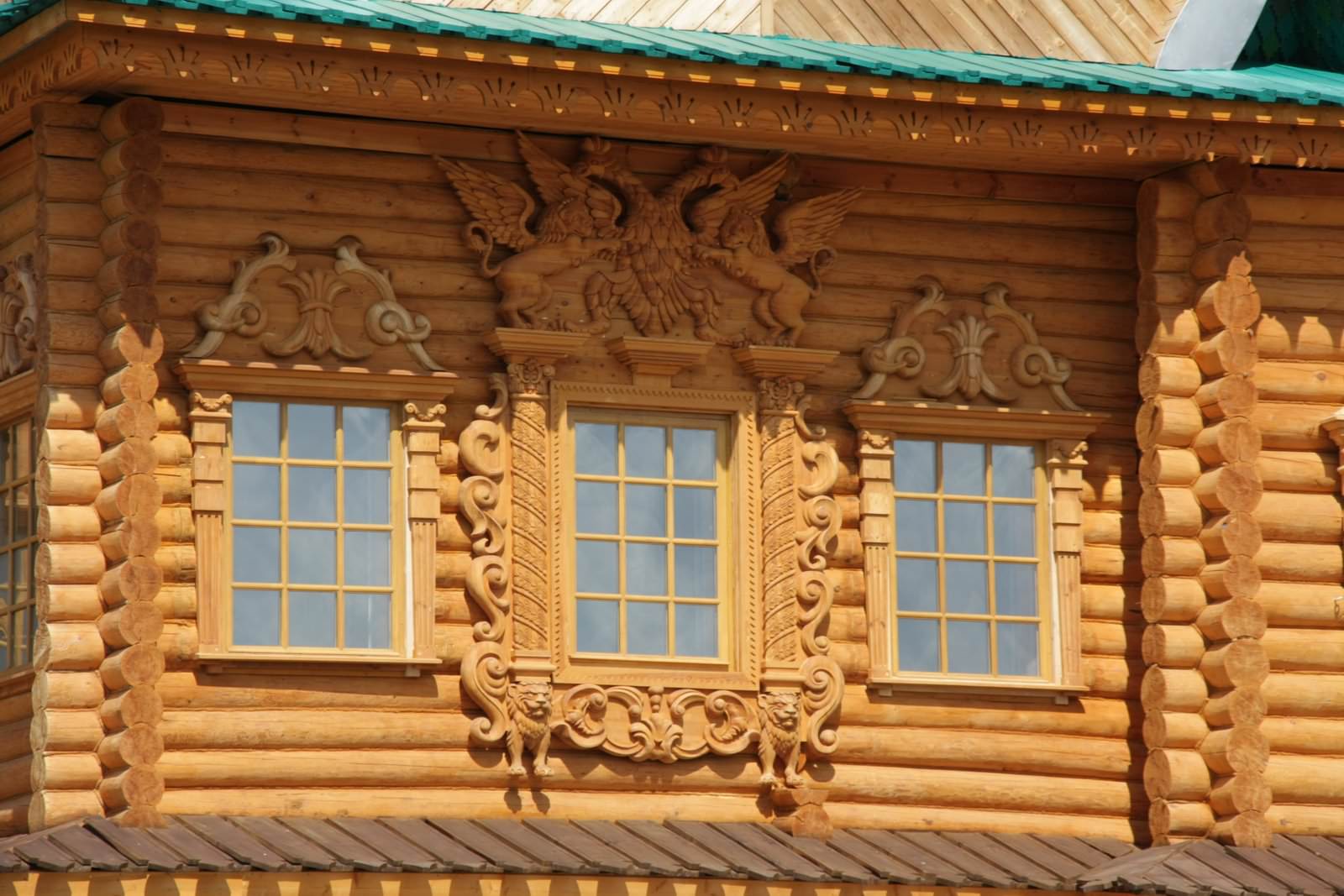
- If you are just starting to work on a stencil on a platband pattern, you should choose a simpler pattern with large shapes. The smaller the drawing, the more complex it is. It is good to try elements of the pattern from through holes.
- Open elements are cut with a jigsaw.
- Beech, larch and oak are expensive and difficult to work with, but they have a long service life.
- The easiest to process is a material such as linden.
- The material most commonly used is pine.
As soon as people began to live in caves and huts, they immediately woke up a craving for beauty. They wanted to decorate their homes with what seemed to them the most attractive. This was done in order to scare away other tribes, as well as to show their status and importance. For the same purposes, they decorated themselves. Later, with the advent of the polytheistic religion, decorations began to be made in order to appease the gods: in time to cause rain, drive away evil spirits, get a harvest, and so on. Much later, decorating a house became a real art that required skill and perseverance. In the summer, people worked in the fields, and in the short winter days they could afford to indulge in such a hobby as carving. Various ornaments served as amulets, figurines of animals and birds were carved, plant elements were used. We will tell and show everything about house carving and its interesting facts!
Later, a separate branch of woodcarving was formed to decorate the facades and platbands of the house, which was called house carving.
It is better to collect material for woodcarving in winter - the tree is drier at this time of the year, the juice does not circulate in it. The blanks are dried for several years, but in construction and specialized stores you can buy ready-made timber.
For internal works softwoods such as linden and alder are well suited, and hardwoods, conifers, are well suited for outdoor decoration. They are more difficult to cut, but they last much longer. In addition, with modern tools, hardness is not a big problem: a router or an electric jigsaw is often used for house carving. To get beautiful products, you do not need to have the ability to draw. It is enough just to hold the tool firmly in your hand and cut clearly according to the stencil.
It should be noted that for the exterior decoration of the house, the technique of slotted carving is most often used.
Before you start carving for your home: tools, tips, preparation
First you need to purchase a tool. It can be a manual or electric jigsaw with a set of files or a router. You will also need a drill, sandpaper, and also varnish or paint suitable for outdoor work; brushes for them.

It is necessary to measure all parts of the house that are to be decorated. According to the dimensions, pick up bars with a thickness of 1.5-2.5 cm. It is important to ensure that they are made of hard wood, do not have cracks, knots and chips.

Safety when working with wood and power tools
Work should be done outdoors or in well-ventilated areas, it is best to wear safety glasses and a respirator: chips and sawdust can get into the eyes and lungs, which should be avoided. For the convenience of work, good uniform lighting is also very important in order to see all the details and patterns that are to be cut.
Where to find sketches for house woodcarving for exterior
There are a huge number of books in the public domain and in stores where you can find a huge number of sketches and ideas for house carving with photos and examples of the work of craftsmen. Not less interesting solutions can be found on the Internet. After the template is selected, it is necessary to fit it to the desired dimensions. You can use graphic editors or do it yourself.

Where to start do-it-yourself wood carving
A template is cut out of thick cardboard, previously drawn or printed from the Internet. This is, as a rule, a small fragment of a pattern that is repeated many times on a casing or other element of a house. It must be traced with a pencil on a prepared and pre-sanded bar, after which the stencil must be moved and circled as many times as the size of the future decor element requires.
After the “pattern” is transferred to the tree, you first need to cut out the shape of the product, that is, the external contours, then drill holes in future cutouts with a drill and expand them to the desired size and shape with your main tool.

What determines the result and appearance of the product in the technique of house carving?
The work is simple, but painstaking, requires patience and accuracy, because the smoother the pattern, the better the result looks. It is important to remember about symmetry: for example, the right and left window trims must be cut in a mirror, all patterns must be at the same height and the same width. In this case, the house will turn out really beautiful, it will be pleasant to look at it and it is impossible to look away.

How to correctly install overlays in their places
Parts must be coated with paint or varnish before they are installed.
There are several types of fasteners for overhead elements. Usually blind dowels are used for this, accurately measuring the distances on the wall and the attached part. In this case, the fastener will not be visible from the side, it is reliable and convenient. There is another option, easier and more convenient: to nail the part with nails. There is a drawback to this method: the heads of the nails will be visible, and they may rust over time. To prevent this, the hats are already in place covered with the same paint as the decor element itself.

A selection of videos on the topic “House woodcarving”
For buildings made of log cabins, carved architraves simply suggest themselves for decorating window openings. Them independent production- not at all a whim or an attempt to save money, because there are very few really good woodcarvers now.
Required minimum tool
The manufacture of platbands, unlike artistic wood carving, involves the repeated execution of the same type of operations, resulting in a rather primitive repeating pattern. Therefore, most of the work is done with an electric tool: this not only increases the processing speed, but also achieves uniform quality in different areas.
 1 - jigsaw; 2 - drill; 3 - belt grinder; 4 - vibration grinder; 5 - manual router
1 - jigsaw; 2 - drill; 3 - belt grinder; 4 - vibration grinder; 5 - manual router
The main work is done with a jigsaw and a drill. The tool must be reliable and of high quality, capable of being in continuous use for a long time. For cleaning and grinding products, it is better to use an electric grinder, at least the simplest belt grinder. Fast finishing of the relief is possible using vibration-type machines.
If you intend to add additional fine details to the edges of your product, you can not do without a router. Descents, chamfers and a figured border can also be done manually, but only with a variety of chisels, cutters and specific skills in working with wood.

How to choose wood
For platbands, hardwoods are best suited: oak, birch, ash, maple, alder. Since the thickness of the finished product is relatively small (30-45 mm), hard rocks will be less prone to rotting and drying out, therefore, they will retain their appearance.

If you plan to decorate carved platbands with flat-relief elements with many small details, you should give preference to softer rocks with small pattern textures. Suitable linden, poplar, aspen, walnut and spruce.
Wood for platbands should be selected and, preferably, chamber dried, with a moisture content not higher than 12%. It is not allowed to have traces of warping or other pronounced defects, large branches. Ideally, you should immediately order calibrated boards with a width of 100-150 mm and a thickness of 30-40 mm.

The length of the blanks should be sufficient to completely cover the window opening horizontally and vertically with an overlap in each direction by 1.5 board widths. It is important that you initially calculate the number of blanks needed and, in addition to them, purchase a few more boards of the cheapest breed for training and carving skills.
Making templates and stencils
Almost any wood carving begins with drawing a pattern on a workpiece according to a pre-made template or stencil. There are plenty of threading schemes in the network, the main difficulty comes down to transferring lines to the part accurately and without distortion. We will warn you right away: do not chase the high complexity of the drawing. A set of even the most primitive elements in the correct sequence and with well-chosen indents takes its modesty and quality of processing.


The first option for marking is the manufacture of a small piece of plastic or solid sheet material, on which a single element of a repeating pattern is applied. Such a template is successively applied to the workpiece and outlined in pencil.
It is also possible to produce a single template. You need to take a strip of paper of the appropriate width, fold it with an accordion several times, and then cut out the pattern according to the principle of a Christmas tree garland. The resulting tape must be glued onto cardboard or LMDF, and then cut out the desired shapes. This method is welcomed with a significant amount of work.

The resulting stencil is subsequently simply superimposed on the board and outlined with a soft pencil. Ideally, saturated, but precise cut lines and boundaries for further processing should remain. When marking out the details, it is also necessary to take into account the layout of the pattern so that the platbands form a solid and complete contour, and the repeating pattern is not interrupted out of place.

Through hole selection
The first step is to trim the edges of the workpiece and select holes in the center. With the edges, everything is simple: we cut out the excess with a jigsaw, stepping back from the marking line 1-1.5 mm outward for further processing. To cut out figures in the center of the plane, we drill a part at the very line of each cutout, then select the inner contour with a jigsaw.
![]()
For making large holes, it is reasonable to use core drills. In this case, it is necessary to mark on the template not the contours, but the centers of the circles in which the centering drill bit of the crown will be installed. A similar technique can also be used in the manufacture of oval holes or elements with small rounding radii: a complex bend is drilled with the appropriate radius, and everything else is cut out with a jigsaw.

When the excess parts of the workpiece are sawn out, the cut edges must be carefully processed with a rasp and then sandpaper. It is recommended to use bars of square, round and rounded profiles, on which sandpaper is stuffed. This way you are less likely to "collapse" the edges and you can get right angles on each edge.

Rectangular edges look rather rough, so they are smoothed out with chamfers and slopes of different profiles. The easiest way to diversify the product is to walk along the outer and inner contours of the casing with a figured cutter. But manual processing options are also possible:
- to chamfer, walk along straight edges with a chip, keeping the angle of inclination of the handle to the part constant;
- a semicircular convex descent can also be made with chips, changing the slope of the blade, or use a concave cutter for this;
- concave semicircular pairing is performed with a chisel or a cutter with a rounded edge. Such elements must be cut out in stages, removing small chips layer by layer and carefully controlling the depth of the tool and the tilt of the handle;
- if the descent has a complex profile with several convex, concave and straight elements, this profile is divided into several stages and cut in strict sequence, starting from the widest outer part and ending with the deepest and shallowest tier.


Blind carving: we apply a relief
When you're done with shaping, it's a good idea to diversify the remaining flat pieces with simple ornaments or floral designs. Here are the simplest ways to work:
- A groove (branch, furrow) is made with a narrow chisel or cutter with a square, triangular or concave blade shape. The carving is carried out strictly along the line, the relief is selected with small chips and then polished.
- Sheet - several small grooves that imitate veins cut with a circular knife. From the center between the veins to each of them, small notches are made with a semicircular chisel, imitating the body of a leaf, then an external contour is drawn with a thin cutter.
- The flat areas adjacent to the descent can be diversified with a blind carving of a small ornament. For example, cut two grooves from the edge, forming a triangle with it, and punch an asterisk in the center with a notch.


Wood processing and installation of architraves
Due to the carved elements, the wooden product has a large surface shape, due to which it is more susceptible to aging. Therefore, wood should be treated in a special way.
First of all, carvings for placement on the facade should be soaked in an antiseptic composition for 5-8 hours, for which you can dig a small trench in the ground and put a plastic film there to temporarily equip the bath. After soaking, the parts are dried for several days stacked with linings after 30-40 cm.

When the wood has dried, it must be carefully sanded, achieving smoothness and finally eliminating all traces of sawing and carving. The protective composition is selected according to the type facade decoration, it can be either alkyd enamel or polyurethane varnish, tinted or transparent.
Finally, for correct installation platbands, the window opening should be framed with a flat rail 10-15 mm thick and so wide that its outer edge is not visible through the carved pattern along the platband contour. The purpose of this plank is to eliminate the remaining irregularities in the wall and provide a solid base for the carved element to be attached to. Often this rail is painted in a color that contrasts with the coating of the casing itself for greater expressiveness of the pattern.

Platbands can be attached with straight and oblique trim, depending on the type and density of the pattern. Oblique trimming is performed with a 45° cut on each side, while the cutting line must pass through identical sections of the pattern and not cross the figures cut inside.

With a straight cut, a horizontal element is placed between two vertical ones. Their upper edge should be 1-2 cm above the crossbar if the cut end is straight. It is also possible to manufacture on the edge of the thread according to the general scheme, if during the manufacturing process the fitting and precise fitting of the trims is carried out. The very fastening of the platbands is elementary - for it they use ordinary ruffed nails without a hat. It is only important that the nail pierces the casing and the lath, protruding at least 5 mm from the inside.
Do-it-yourself window trims are a wonderful decoration for the facade of the house (ready-made stencils and templates will be given in the article below). They make the house look like no other, visually change its proportions.
Today, having certain skills, you can independently create elegant platbands for windows in a wooden structure. Moreover, they can be made not only from wood, but also from other materials.
Specificity
 When the owner decides to mount the platbands, he seeks to arrange traditional decor in his possessions.
When the owner decides to mount the platbands, he seeks to arrange traditional decor in his possessions.
Platbands have the following advantages:
- Excellent decorative function. So the building visually increases.
- Complementing the overall style of architectural design.
- The space between the window opening and the wall plane is protected from moisture and dust.
- Reduced heat loss and noise levels.
- The individual features of the house and the style of the chosen era are highlighted.
There are platbands and shortcomings:
- Wood needs a certain treatment from high humidity and deformation.
- Products need regular care and processing.
- They do not harmonize with metal-plastic windows. In this case, the platbands are made in the same color scheme.
Self-creation of templates
 Today there are many platbands. Their types are determined by the way they are mounted to the window. There are two types of this criterion:
Today there are many platbands. Their types are determined by the way they are mounted to the window. There are two types of this criterion:
- Telescopic. Their specifics: L-shaped protrusions, coinciding with the grooves of the window frame.
- Overhead. Installation takes place on the window frame. Fasteners - construction glue or nails with screws.
Note: finished samples are created in full size. They are printed according to the required parameters.
An elegant solution is the installation of carved products. Such plans can be realized independently only with special equipment.
Popular materials

- The most common material for platbands is wood. Products from it have an elegant and harmonious appearance.
- Plastic versions are often used as well. They are characterized by powerful resistance to temperature changes and ultraviolet radiation. Plastic options are sold already finished.
- Another popular material is MDF. It is made from wood waste. It is more environmentally friendly than plastic. In addition, products made from it are characterized by a look reminiscent of natural wood.
- Polyurethane. Variations from it are highly practical. Facade stucco molding is often made from this material.
The nuances of choosing the right wood
 As already noted, wood is the most popular material for platbands. And the performance of wooden platbands depends on the type of wood used.
As already noted, wood is the most popular material for platbands. And the performance of wooden platbands depends on the type of wood used.
Here, attention is usually paid to such options.
- Hard deciduous. These varieties include ash, oak and beech. They are very durable. But it is quite problematic to create patterns on them.
- Soft leafy. These are: linden, aspen and alder. They are easier to process. On their surface patterns are created even by hand. And such surfaces are thoroughly processed by special means.
- Cherry and apple tree. They are optimal for creating small components that can be attached to the base.
- Pine and birch. They are also easy to handle. And they have excellent working qualities.
- Various combinations of wood types. The use of special protective compounds for powerful impregnation is mandatory here.
With the help of wood High Quality it turns out a beautiful original design of the window opening.
The nuances of creating templates with your own efforts
The basis of the work is to create stencils and design.
Self-printing stencils is quite feasible for everyone. It is important to achieve a combination of the selected ornament with the whole style. Mixing geometric and floral patterns is not allowed.

When working on platbands, the following subtleties are taken into account:
- There should be harmony in the color palette of the walls and decorative elements.
- Be sure to select the correct parameter. The platbands should not be very wide or small.
- A high-quality version of the coating is selected. Special paints are used.
- A template is needed for the manufacture of external carved components.
- The drawing is correctly positioned on the workpiece. Details follow along the wood fibers.
When you can achieve color combination architraves and the plane of the walls, it turns out a holistic and harmonious facade.
Manufacturing stages
Before creation window decor carved platbands are selected from photographs. You need to make a template first. It should turn out the same for the design work of all openings.
![]()
Typically, the following methods of creating patterns are used:
- Applied thread. It has isolated elements of the pattern. They join the same base.

Installation of overhead components should be on the base in compliance with the template pattern.
- slotted thread. Here they make a through ornament. It looks like wood lace.

With all methods of work, the presence of stencils is mandatory. This is how they look:
Advice: for simple patterns, it is not necessary to make a large-scale stencil. Enough of the notebook paper.
You also need to have the following tools:
- Jigsaw.
- Hacksaw (oriented for wood).
- Knives and chisels.
- Drill.
- Milling technology
Platbands must be created from prepared materials. The working stages are:
- Rigorous measurements are taken.
- The selected tree must be dry. If it is wet or damp, it must be brought to dry conditions. The width of the boards is determined by the parameters of the window opening. In thickness, the material reaches a minimum of 3 cm if a slotted thread is made, and at least 1 cm when an overhead thread is made.
 All blanks are pre-treated with a protective compound. Their cutting is done using templates. And the cutting of ornaments takes place using a jigsaw. This tool is better to use different types of files.
All blanks are pre-treated with a protective compound. Their cutting is done using templates. And the cutting of ornaments takes place using a jigsaw. This tool is better to use different types of files.
To work with an electric jigsaw, certain skills and special care are needed. The created holes must be overwritten. An excellent tool for this is sandpaper. After powerful grinding, the part is treated with a special impregnation.
Next comes the installation of all prepared parts to the base. Here you need to use glue or special nails. In such work, it is better to refuse the use of self-tapping screws. They will cause cracking of products.
Installation specifics
 The created platband can be attached to the desired position using the following methods:
The created platband can be attached to the desired position using the following methods:
- On a dull thorn. Installation of such parts is on the inside. Especially for them, holes should be made in the frame. Glue is applied to the spike and distributed evenly. The spike is inserted into the groove. This fastening protects the platbands from dust and moisture.
- With the use of a through spike. The butt section here is thoroughly treated with varnish.
These techniques are justified when working with a wooden window. To attach to metal-plastic, a special powerful liquid glue is used.
Care Required
 Installed platbands need constant attention and care. Used for processing special preparations- powerful impregnations. They create high-quality protection against:
Installed platbands need constant attention and care. Used for processing special preparations- powerful impregnations. They create high-quality protection against:
- tree pests;
- the appearance of cracks;
- sudden fire.
Carved options are necessarily covered with a primer, then varnish or paint. The intensity of such treatments is 1 time in 3-5 years. So the operational life of the products will be seriously developed, and at the same time their attractive appearance will be preserved.
When installing plastic or metal products, some kind of thorough maintenance is not needed. For products, it is necessary to arrange high-quality protection against corrosion. Periodic updating of the paint is also required.
Thus, it is very possible to make platbands of extraordinary beauty with elegant patterns on your own. Certain carpentry, carpentry and tool skills are required. So you decorate window openings in a very original way and bring an elegant zest to the chosen architectural style.
How carved platbands are made using the slotted carving technique, see the following video:




















